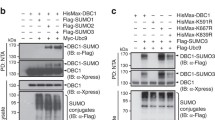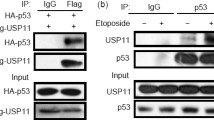Abstract
The tumor suppressor p53 is at the hub of cellular signaling networks that are activated by stress signals including DNA damage. In the present study, we showed that programmed cell death 5 (PDCD5) bound to p53 by glutathione S-transferase (GST)-pulldown, co-immunoprecipitation and co-localization assays. PDCD5 enhanced the stability of p53 by antagonizing Mdm2-induced p53 ubiquitination, nuclear export and proteasomal degradation. We also found that PDCD5 could dissociate the interaction between p53 and Mdm2 and interact with Mdm2 directly to promote its degradation. In cells with or without induction of DNA damage, knockdown of PDCD5 by RNA interference decreased the p53 phosphorylation at Ser9, 20 and 392 residues, as well as the expression of p21 protein. Additionally, chromatin immunoprecipitation assays showed an up-regulated association of PDCD5 at the p53BS2 site of the p21 promoter during DNA damage. Cell cycle analysis also indicated that PDCD5 was required in G1 phase cell arrest during DNA damage. In summary, PDCD5 may contribute to maintain a basal pool of p53 proteins in unstressed conditions, but upon DNA damage it functions as a co-activator of p53 to regulate transcription and cell cycle arrest.








Similar content being viewed by others
References
Hollstein M, Sidransky D, Vogelstein B, Harris CC (1991) p53 mutations in human cancers. Science 253:49–53
Laptenko O, Prives C (2006) Transcriptional regulation by p53: one protein, many possibilities. Cell Death Differ 13:951–961
Hanahan D, Weinberg RA (2000) The hallmarks of cancer. Cell 100:57–70
Mihara M, Erster S, Zaika A et al (2003) p53 has a direct apoptogenic role at the mitochondria. Mol Cell 11:577–590
Kubbutat MH, Jones SN, Vousden KH (1997) Regulation of p53 stability by Mdm2. Nature 387:299–303
Leng RP, Lin Y, Ma W et al (2003) Pirh2, a p53-induced ubiquitin-protein ligase, promotes p53 degradation. Cell 112:779–791
Dornan D, Wertz I, Shimizu H et al (2004) The ubiquitin ligase COP1 is a critical negative regulator of p53. Nature 429:86–92
Chen D, Kon N, Li M et al (2005) ARF-BP1/Mule is a critical mediator of the ARF tumor suppressor. Cell 121:1071–1083
Brady CA, Jiang D, Mello SS et al (2011) Distinct p53 transcriptional programs dictate acute DNA-damage responses and tumor suppression. Cell 145:571–583
Bode AM, Dong Z (2004) Post-translational modification of p53 in tumorigenesis. Nat Rev Cancer 4:793–805
Higashimoto Y, Saito S, Tong XH et al (2000) Human p53 is phosphorylated on serines 6 and 9 in response to DNA damage-inducing agents. J Biol Chem 275:23199–23203
Sakaguchi K, Saito S, Higashimoto Y et al (2000) Damage-mediated phosphorylation of human p53 threonine 18 through a cascade mediated by a casein 1-like kinase. Effect on Mdm2 binding. J Biol Chem 275:9278–9283
Abraham RT (2001) Cell cycle checkpoint signaling through the ATM and ATR kinases. Genes Dev 15:2177–2196
Banin S, Moyal L, Shieh S et al (1998) Enhanced phosphorylation of p53 by ATM in response to DNA damage. Science 281:1674–1677
Tibbetts RS, Brumbaugh KM, Williams JM et al (1999) A role for ATR in the DNA damage-induced phosphorylation of p53. Genes Dev 13:152–157
Hirao A, Kong YY, Matsuoka S et al (2000) DNA damage-induced activation of p53 by the checkpoint kinase Chk2. Science 287:1824–1827
Shieh SY, Ikeda M, Taya Y, Prives C (1997) DNA damage-induced phosphorylation of p53 alleviates inhibition by MDM2. Cell 91:325–334
Lu H, Fisher RP, Bailey P, Levine AJ (1997) The CDK7-cycH-p36 complex of transcription factor IIH phosphorylates p53, enhancing its sequence-specific DNA binding activity in vitro. Mol Cell Biol 17:5923–5934
Liu H, Wang Y, Zhang Y et al (1999) TFAR19, a novel apoptosis-related gene cloned from human leukemia cell line TF-1, could enhance apoptosis of some tumor cells induced by growth factor withdrawal. Biochem Biophys Res Commun 254:203–210
Wang Y, Li X, Wang L et al (2004) An alternative form of paraptosis-like cell death, triggered by TAJ/TROY and enhanced by PDCD5 overexpression. J Cell Sci 117:1525–1532
Chen Y, Sun R, Han W et al (2001) Nuclear translocation of PDCD5 (TFAR19): an early signal for apoptosis? FEBS Lett 509:191–196
Spinola M, Meyer P, Kammerer S et al (2006) Association of the PDCD5 locus with lung cancer risk and prognosis in smokers. J Clin Oncol 24:1672–1678
Yang Y, Zhao M, Li W et al (2006) Expression of programmed cell death 5 gene involves in regulation of apoptosis in gastric tumor cells. Apoptosis 11:993–1001
Ruan G, Qin Y, Chen S et al (2006) Abnormal expression of the programmed cell death 5 gene in acute and chronic myeloid leukemia. Leuk Res 30:1159–1165
Du Y, Xiong L, Lou Y, Tan W, Zheng S (2009) Reduced expression of programmed cell death 5 protein in tissue of human prostate cancer. Chin Med Sci J 24:241–245
Zhang X, Wang X, Song X et al (2011) Clinical and prognostic significance of lost or decreased PDCD5 expression in human epithelial ovarian carcinomas. Oncol Rep 25:353–358
Li H, Wang Q, Gao F et al (2008) Reduced expression of PDCD5 is associated with high-grade astrocytic gliomas. Oncol Rep 20:573–579
Chen C, Zhou H, Xu L et al (2010) Prognostic significance of downregulated expression of programmed cell death 5 in chondrosarcoma. J Surg Oncol 102:838–843
Ruan G, Zhao H, Chang Y et al (2008) Adenovirus-mediated PDCD5 gene transfer sensitizes K562 cells to apoptosis induced by idarubicin in vitro and in vivo. Apoptosis 13:641–648
Chen C, Zhou H, Xu L et al (2010) Recombinant human PDCD5 sensitizes chondrosarcomas to cisplatin chemotherapy in vitro and in vivo. Apoptosis 15:805–813
Shi L, Song Q, Zhang Y et al (2010) Potent antitumor activities of recombinant human PDCD5 protein in combination with chemotherapy drugs in K562 cells. Biochem Biophys Res Commun 396:224–230
Wang Y, Song Q, Zhang Y et al (2009) Recombinant human PDCD5 protein enhances chemosensitivities of hematologic malignancies. Chin Sci Bull 54:3981–3989
Ma X, Ruan G, Wang Y et al (2005) Two single-nucleotide polymorphisms with linkage disequilibrium in the human programmed cell death 5 gene 5′ regulatory region affect promoter activity and the susceptibility of chronic myelogenous leukemia in Chinese population. Clin Cancer Res 11:8592–8599
Xu L, Chen Y, Song Q et al (2009) PDCD5 interacts with Tip60 and functions as a cooperator in acetyltransferase activity and DNA damage-induced apoptosis. Neoplasia 11:345–354
Chen L, Wang Y, Ma D, Chen Y (2006) Short interfering RNA against the PDCD5 attenuates cell apoptosis and caspase-3 activity induced by Bax overexpression. Apoptosis 11:101–111
Li P, Wang D, Yao H et al (2010) Coordination of PAD4 and HDAC2 in the regulation of p53-target gene expression. Oncogene 29:3153–3162
Chen D, Zhang Z, Li M et al (2007) Ribosomal protein S7 as a novel modulator of p53-MDM2 interaction: binding to MDM2, stabilization of p53 protein, and activation of p53 function. Oncogene 26:5029–5037
Dai MS, Lu H (2004) Inhibition of MDM2-mediated p53 ubiquitination and degradation by ribosomal protein L5. J Biol Chem 279:44475–44482
Jin A, Itahana K, O’Keefe K, Zhang Y (2004) Inhibition of HDM2 and activation of p53 by ribosomal protein L23. Mol Cell Biol 24:7669–7680
Lohrum MA, Ludwig RL, Kubbutat MH, Hanlon M, Vousden KH (2003) Regulation of HDM2 activity by the ribosomal protein L11. Cancer Cell 3:577–587
Yao H, Feng Y, Zhou T, Wang J, Wang Z (2012) NMR studies of the interaction between human programmed cell death 5 and human p53. Biochemistry 51:2684–2693
Schon O, Friedler A, Freund S, Fersht AR (2004) Binding of p53-derived ligands to MDM2 induces a variety of long range conformational changes. J Mol Biol 336:197–202
Meek DW (1994) Post-translational modification of p53. Semin Cancer Biol 5:203–210
Acknowledgments
This work was supported by Grants from the National Key Project for Basic Research of China (973, 2011CB910103) and the National Natural Science Foundation of China (30871263).
Author information
Authors and Affiliations
Corresponding author
Rights and permissions
About this article
Cite this article
Xu, L., Hu, J., Zhao, Y. et al. PDCD5 interacts with p53 and functions as a positive regulator in the p53 pathway. Apoptosis 17, 1235–1245 (2012). https://doi.org/10.1007/s10495-012-0754-x
Published:
Issue Date:
DOI: https://doi.org/10.1007/s10495-012-0754-x




